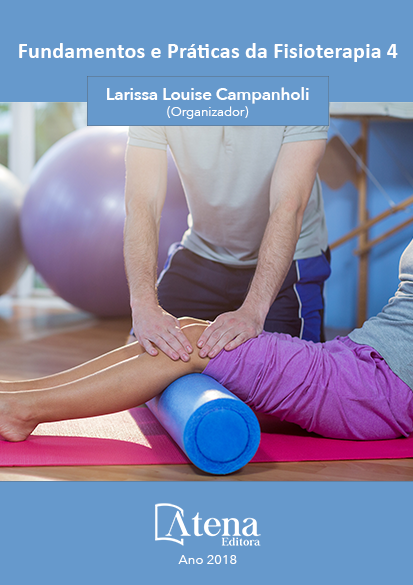
EFEITOS DA TÉCNICA DE MOVIMENTOS OSCILATÓRIOS E/OU BREVEMENTE MANTIDOS SOBRE O TECIDO NEURAL EM PORTADORES DE LOMBOCIATALGIA CRÔNICA NÃO ESPECÍFICA
A lombociatalgia é caracterizada
como um processo doloroso de origem lombar
com irradiação para os membros inferiores,
seguindo o trajeto neuronal do nervo acometido.
Considera-se lombociatalgia crônica aquela
com sintomatologia há três meses, sintomas
de distúrbios sensoriais, fraqueza muscular,
restrição da mobilidade irradiando-se entre
a nádega e face posterior da coxa, podendo
estender-se até o pé. O ciclo dor-imobilizaçãodor
torna o indivíduo com limitações em suas
atividades diárias, afastando-o muitas vezes de
suas atividades ocupacionais. O fisioterapeuta
podes auxiliar na melhora do quadro
fisiopatológico do indivíduo, visando o retorno
a suas atividades de vida diária e melhora da
capacidade funcional. O objetivo do estudo
foi avaliar os efeitos da mobilização neural
em indivíduos com lombociatalgia crônica não
específica, por meio da Escala de Incapacidade
Funcional Roland Morris, Slump Test e Elevação
da Perna Estendida. A amostra foi composta
por seis mulheres com idade entre 45-69,
residentes em Erechim/RS. Foram realizadas
vinte sessões de fisioterapia, três vezes por
semana, sendo o tratamento fisioterapêutico
composto das técnicas “Movimento Deslizante
Slump” e “Mobilização Tensionante Distal do
Isquiático”. Os testes utilizados foram o Slump
Test, Elevação da Perna Estendida e Escala de
Incapacidade Funcional Roland Morris, ambos
aplicados na 1ª, 10ª e 20ª sessão. A estatística
foi analisada com o teste de Wilcoxon, com
significância de p≤0,05. Conclusão: Nossos
resultados sugerem que o tratamento utilizado
promoveu melhora na capacidade funcional,
em relação ao aparecimento da sintomatologia
neural podemos observar que 33,33% da
amostra total, obteve-se benefícios analgésicos
após a vigésima sessão de fisioterapia.
EFEITOS DA TÉCNICA DE MOVIMENTOS OSCILATÓRIOS E/OU BREVEMENTE MANTIDOS SOBRE O TECIDO NEURAL EM PORTADORES DE LOMBOCIATALGIA CRÔNICA NÃO ESPECÍFICA
-
DOI: atena
-
Palavras-chave: Lombociatalgia. Tensão Neural. Mobilização Neural. Fisioterapia.
-
Keywords: Lombociatalgia; Neural Tension; Neural Mobilization. Physiotherapy.
-
Abstract:
The lumbar sciatic pain is
caracterized with a dolorous process give rise to
lumbar, wich irradiance affectd pain for lower members, folowed by neuronal way with
nerve affect. Lumbar sciatic pain is considered chronic when your symptoms go beyond
three months. The commons symptoms is pain with sensorial disturbances, muscular
weakness, restriction mobility irradiating between buttocks and posterior face of thigh,
extending to the foot. The cycle pain-imobilization change the person with limitations
in your routine activities, move away for many times during occupational activities.
The physiotherapist can assist in the improvement of the pathophysiological picture
of the individual, aiming at the return to their activities of daily living and improvement
of functional capacity. The objective of the study was to evaluate the effects of neural
mobilization in individuals with chronic nonspecific chronic laryngoscopy, using the
Roland Morris Functional Disability Scale, Slump Test and Extended Leg Elevation. The
sample consisted of six women aged 45-69 residing in Erechim/RS. Twenty sessions
of physiotherapy were performed three times a week, and the physiotherapeutic
treatment was composed of the techniques “Slump Sliding” and “Tension Distal Sciatic
Mobilization”. The tests used were the Slump Test, Extended Leg Lift and Roland
Morris Functional Disability Scale, both applied in the 1ª, 10ª and 20ª session. The
statistic was analyzed with the Wilcoxon test, with significance of p≤0.05. Conclusion:
Our results suggest that the treatment used improves the functional capacity, in relation
to the appearance of the neural symptomatology we can observe that 33.33% of the
total sample, obtained analgesic benefits after the physiotherapy session.
-
Número de páginas: 15
- Karine Carla Zanette
- Rodrigo Arenhart
- Arthiese Korb


